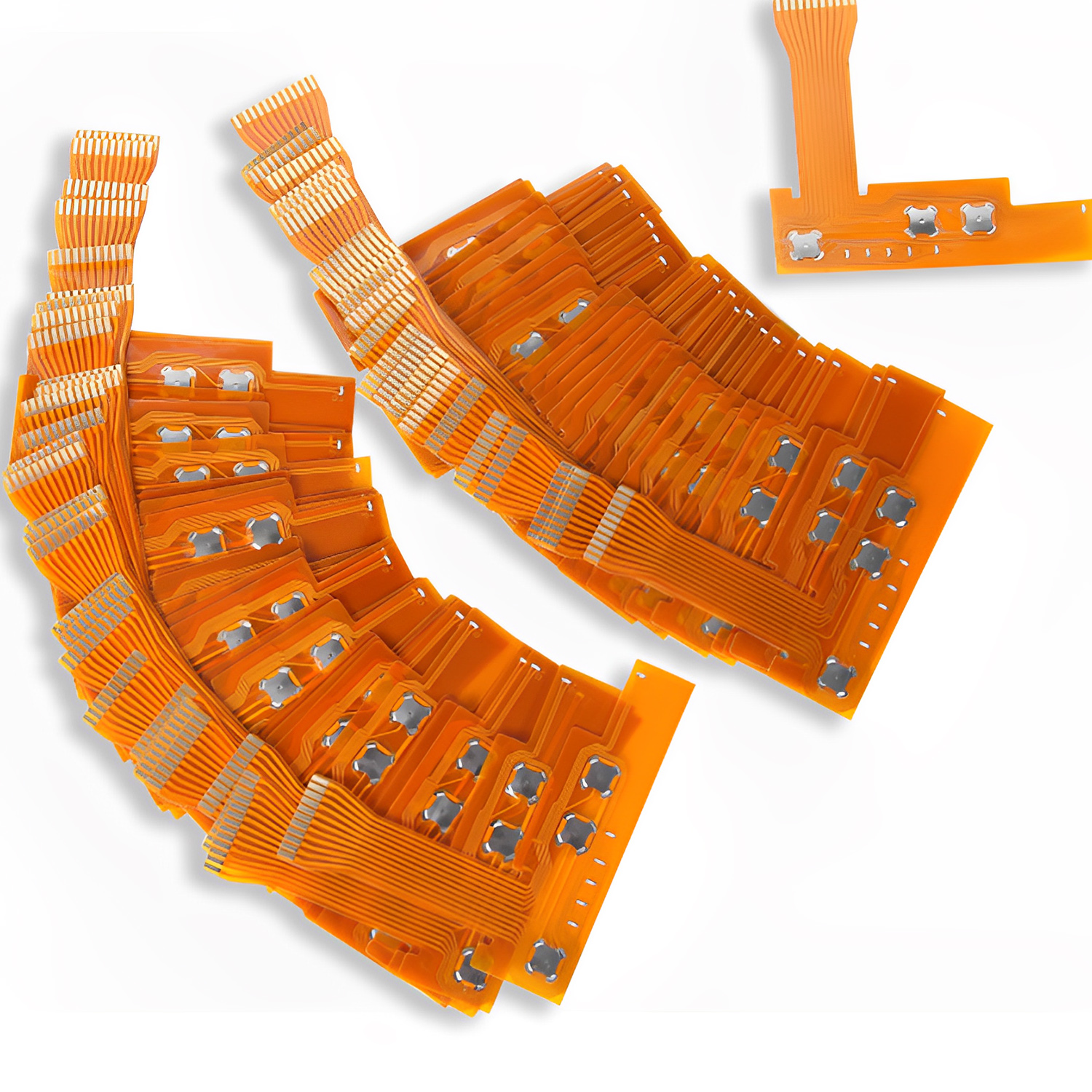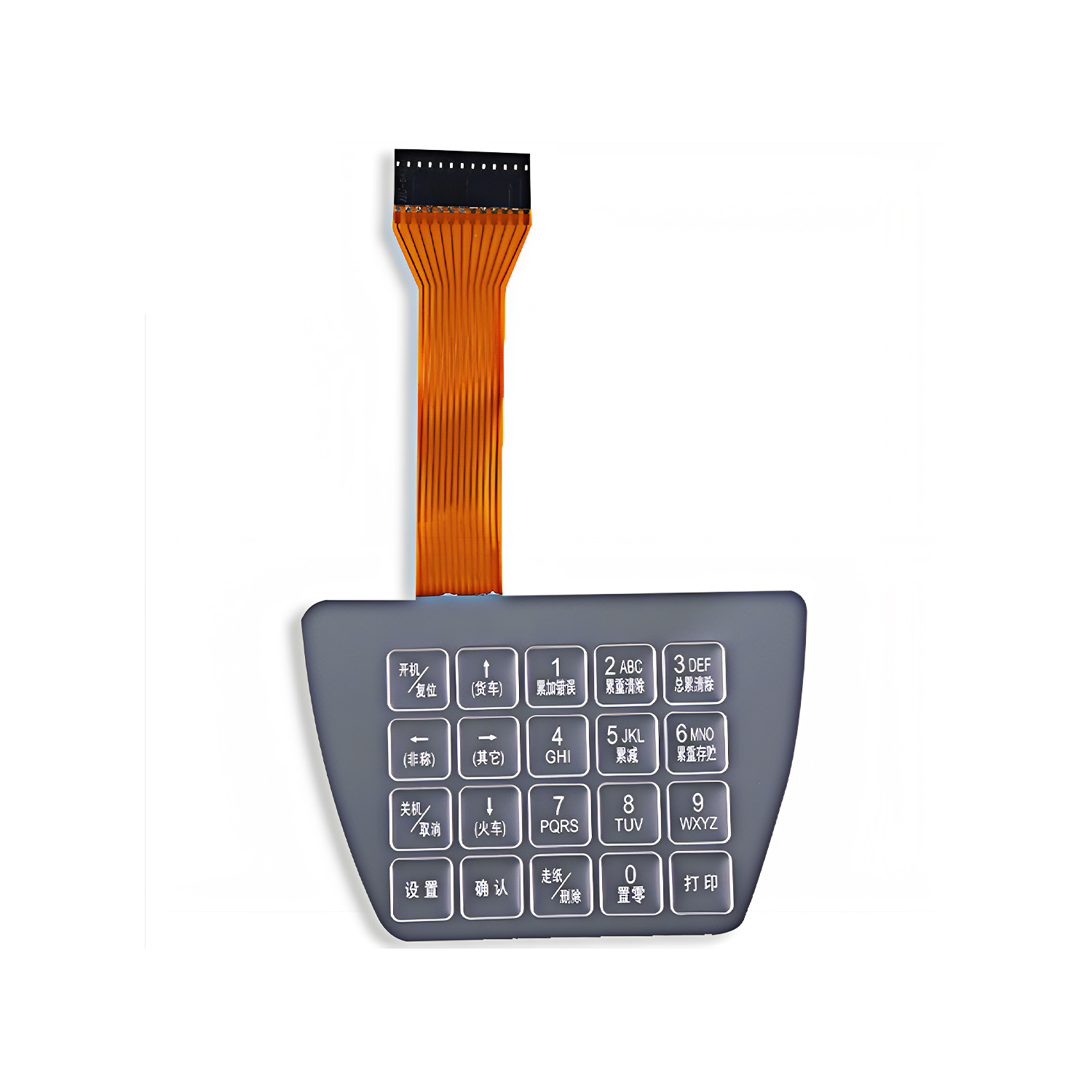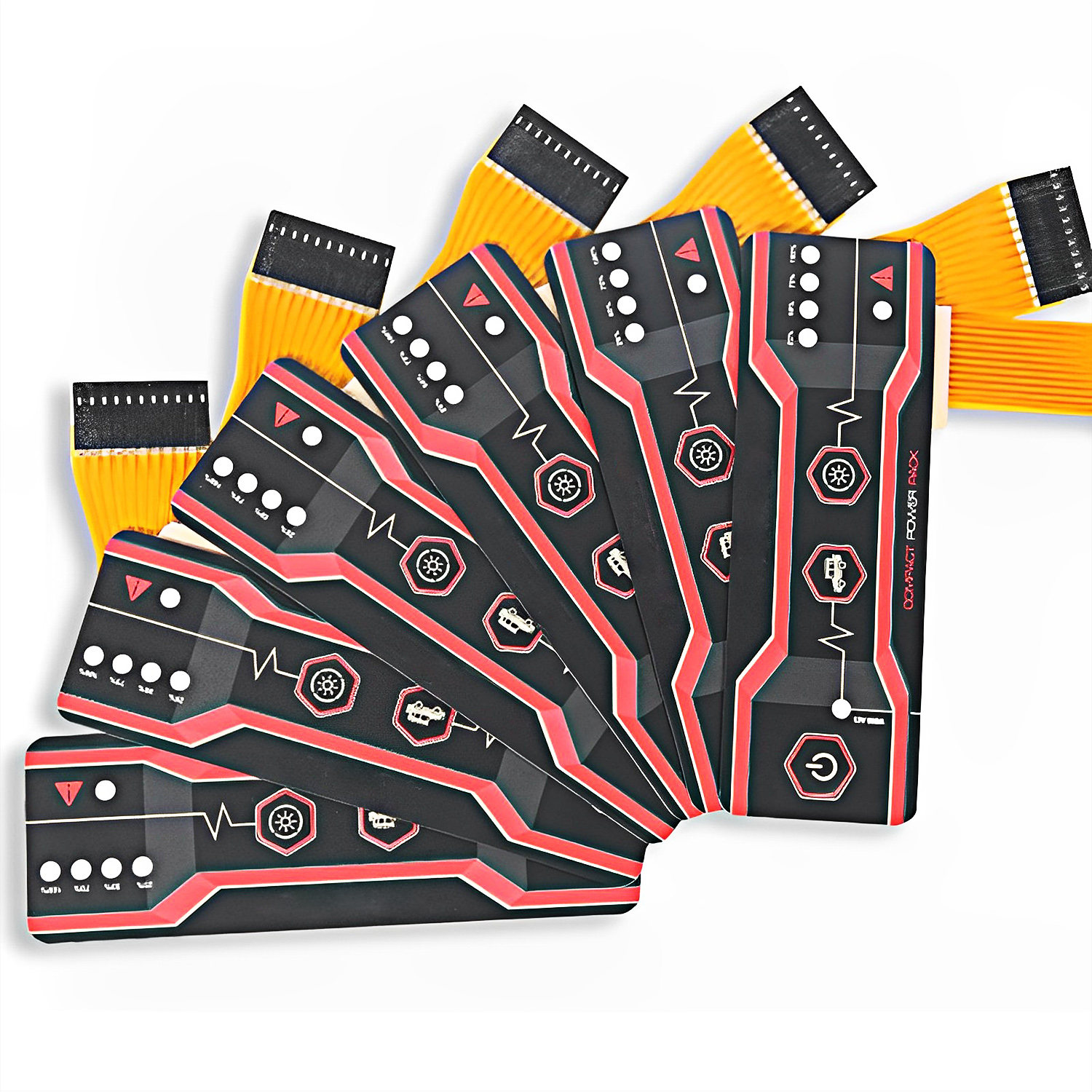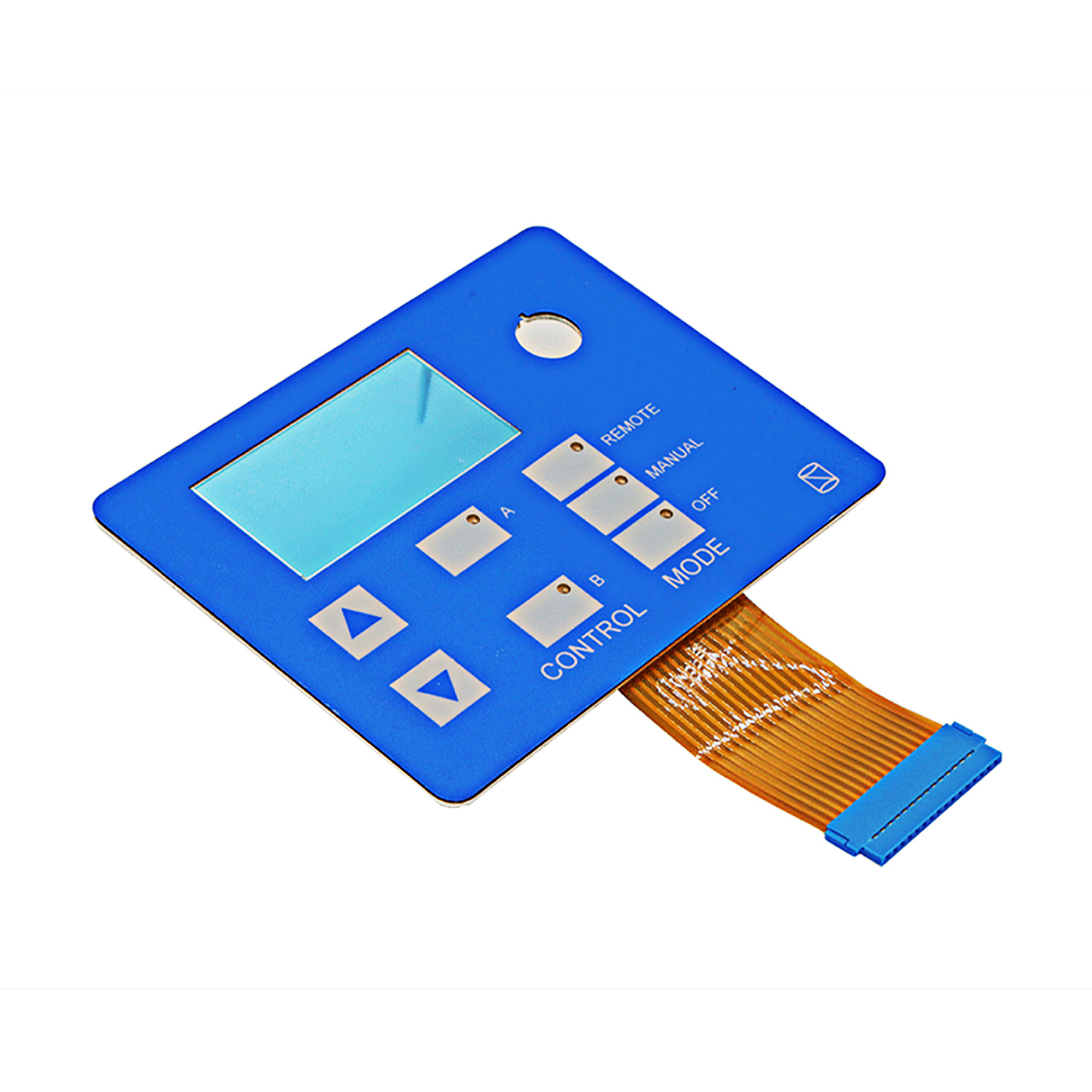




| Flexible Printed Circuit | |
| Working voltage | ≤50V (DC) |
| Working current | ≤100mA |
| Contact resistance | 0.5~10Ω |
| Insulation resistance | ≥100MΩ (100V/DC) |
| Substrate withstand voltage | 2KV (DC) |
| Rebound time | ≤6ms |
| Insulation voltage | 100V/DC |
| Reliability service life | 1 million times |
| Close displacement | 0.1~0.4mm (non-tactile type) , 0.4~1.0mm (tactile type) |
| Migration of conductive | 10MΩ/50VDC between two wires after 56 hours at 55℃, temperature 90% |
| Working temperature | -20℃~+70℃ |
| Storage temperature | -40℃~+85℃, temperature 95%±5% |
| Materials | FR-4,Polyimide etc |
| Colour | Pantone and RAL color matching system |
| Adhesive | 3M,Nitto,Tesa,Epoxy Resin,etc… |
| Printing | Screen Printing, Digital Printing, UV Printing |
| Special Process | Stiffeners etc |
| Thickness of Epoxy | 0.05~4mm |
What is a “Flexible Printed Circuit”?
“Flexible printed circuit” (FPC for short) is a flexible circuit board. FPC is a highly reliable, extremely flexible printed circuit board made of polyimide or polyester film as a substrate, its light weight and thin thickness: this allows FPC to achieve a more compact and thin layout in electronic devices.
Features & Benefits of Flexible Printed Circuit Include:
Product Features
Thin and flexible:
Flexible printed circuit adopts flexible materials such as polyimide or polyester film as the substrate, so it has the characteristics of light weight and thin thickness. This feature enables FPC to achieve a more compact, thin and light layout in electronic devices.
Flexible printed circuit can be bent, folded, and even twisted at will to adapt to the layout needs of a variety of complex shapes and spaces. This high degree of flexibility is unmatched by rigid circuit boards.
High reliability:
Flexible printed circuit adopts advanced manufacturing process and materials to ensure its high reliability and stability. FPC maintains stable performance in harsh environments such as extreme temperatures, vibration and shock.
High wiring density:
Flexible printed circuit can achieve high density wiring in a limited area, thereby improving the integration and functionality of the circuit board. This is of great significance for the miniaturization and highly integrated design of modern electronic equipment.
Good heat dissipation:
Flexible printed circuit has good heat dissipation performance due to the characteristics of its material and structure. This helps to reduce the temperature of the electronic device and improve the stability and reliability of the device.
Diverse design:
Flexible printed circuit can be customized according to specific needs, including single-layer, double-layer, multi-layer and soft and hard combination of different types. This design flexibility enables the flexible printed circuit to meet a variety of complex application scenarios and requirements.
Product Benefits
Save space and weight:
The thin and flexible characteristics of the flexible printed circuit make it possible to greatly save the space and weight of electronic devices. This is of great significance for the pursuit of miniaturization and portability of modern electronic equipment. At the same time, the FPC can also achieve three-dimensional assembly, further improving space utilization.
Improve performance and reliability:
The high wiring density and flexibility of the flexible printed circuit help to improve the performance and reliability of electronic devices. By optimizing the circuit layout and routing mode, the loss and interference of signal transmission can be reduced, and the overall performance of the equipment can be improved. At the same time, the reliability of the FPC is also higher, reducing the failure rate caused by poor contact, broken lines and other problems.
Reduce costs:
Although the initial design and manufacturing costs of flexible printed circuit may be higher, in the long run, it can reduce the overall cost of electronic equipment. This is because FPC is able to reduce the number of redundant cables and connectors, reducing material costs and assembly costs. At the same time, the reliability and durability of the flexible printed circuit also helps to reduce the maintenance and replacement costs of the equipment.
Strong adaptability:
Flexible printed circuit’s diverse design enables it to adapt to a variety of complex application scenarios and requirements. Whether it is aerospace, military fields, mobile communications, consumer electronics, FPC can play its unique advantages and roles.
Improve production efficiency:
FPC’s manufacturing process is relatively simple and easy to automate production, which helps improve production efficiency and reduce labor costs. At the same time, the standardized and modular design of the flexible printed circuit also helps to shorten the product development cycle and time to market.
How Are Flexible Printed Circuit Constructed?
- The substrate
The substrate of the FPC is the basis of the entire circuit board, which determines the flexibility and durability of the circuit board. Common base materials include polyimide (PI) and polyester (PET) films. Polyimide is widely used because of its excellent high temperature resistance, electrical insulation and chemical resistance, while polyester is used in some cases because of its lower cost and better processability.
- Copper foil
Copper foil is the conductive layer of FPC and is used to transmit current and signals. Copper foil materials are divided into rolled copper foil (RA) and electrolytic copper foil (ED), which are different in bending resistance and mechanical properties. Copper foil thickness specifications are varied, common 1OZ (35μm), 1/2OZ (18μm), etc., to meet the needs of different circuit designs.
- The film
The film is the key material connecting the copper foil and the substrate, which provides the adhesive force between the copper foil and the substrate, and ensures the overall stability of the board. In multilayer FPC, the film also plays the role of interlayer insulation.
- Covering film
The covering film is the protective layer on the surface of FPC, which is usually composed of PI film and epoxy adhesive film. It can not only protect the circuit from the erosion of the external environment, but also improve the wear resistance and scratch resistance of the circuit board.
- Reinforcing materials
Reinforcing materials are used to enhance the mechanical strength of FPC to prevent bending or deformation during assembly and use. Common reinforcing materials include PI, PET, FR4 and stainless steel, which each have different temperature resistance properties and cost effectiveness.
- Conductive adhesive
In multilayer FPC, conductive adhesives are used to connect copper foils between different layers to achieve electrical connections of interlayer circuits. Conductive adhesives need to have good electrical conductivity and adhesion to ensure the stability and reliability of the circuit.
- Insulation layer
The insulation layer is located between the various circuit layers and plays the role of isolation and protection. It prevents interference and short circuits between circuits and provides mechanical support for the circuit board. The insulating layer material is usually the same or similar to the substrate material to ensure overall compatibility and stability.
- Other auxiliary materials
In addition to the above main materials, other auxiliary materials may also be used in the manufacturing process of FPC, such as release paper, electromagnetic protective film, etc. These materials play an auxiliary and protective role in the manufacturing and assembly process of the circuit board.
What Special Features Can Be Incorporated into Flexible Printed Circuit?
Multi-layer design and complex wiring
Multi-layer structure: Flexible printed circuit can be designed as a multi-layer structure to accommodate more circuit layers and signal lines, thereby supporting higher wiring density and more complex circuit design. Multi-layer FPC achieves electrical connection between different layers through inner layer interconnection and through-hole technology to meet the needs of high-performance electronic devices.
Rigidity enhancement: In certain areas of the flexible printed circuit, rigid members (such as FR4 materials) can be added to increase its overall rigidity and stability. This design is particularly suitable for applications where large mechanical stresses or specific shapes need to be maintained.
Support structure: In order to ensure that the flexible printed circuit remains flat and stable during use, a support structure can be designed to support and fix the flexible printed circuit. These support structures can be mechanical fixtures, support plates or other forms of fixtures.
Protection and durability design
Protective layer: Add a protective layer, such as polyimide tape or dispense, to the surface or inside of the flexible printed circuit to protect the circuit from environmental factors such as physical damage, moisture, dust and corrosion.
High temperature resistant material: The use of high temperature resistant polyimide material as the substrate, so that the flexible printed circuit can work normally in a high temperature environment, to meet the needs of specific application scenarios.
Precision machining and custom design
Precision machining: Using advanced precision machining technology, such as laser cutting, chemical etching, etc., to accurately process the flexible printed circuit to meet the requirements of dimensional accuracy and shape complexity.
Customized design: According to the specific needs of customers, provide customized flexible printed circuit design services, including circuit layout, material selection, thickness adjustment, etc., to meet the specific needs of different application scenarios.
Embedded components and integrated design
Embedded components: In the manufacturing process of flexible printed circuit, passive components such as resistors, capacitors, and inductors can be directly embedded into the circuit to simplify the assembly process and improve the reliability of the circuit.
Integrated design: Through integrated design, multiple functional modules are integrated into a flexible circuit to achieve functional centralization and modularization, and improve the overall performance and maintainability of electronic equipment.
Design features of Flexible Printed Circuit
Flexible printed circuit has good bending property, and can be freely bent and folded in three-dimensional space to adapt to the layout needs of various complex shapes and Spaces.
Folding design: With a specific folding design, the compact layout and portability of the flexible printed circuit can be achieved while reducing space occupancy and weight. This design makes the flexible printed circuit widely used in portable electronic products such as smart phones, tablets and wearable devices.
BX Panel Flexible Printed Circuit Technical Information
- Material preparation
Prepare flexible substrate (such as polyimide film), conductive layer (copper foil), insulating layer and other materials.
These materials are cut through a cutting machine to the desired size and shape.
- Copper foil attached
The copper foil is attached to the flexible substrate, usually through an adhesive to achieve a strong bond between the copper foil and the substrate.
- Pre-treatment
The surface of the copper foil is cleaned and treated to remove impurities such as oil and oxide and improve the adhesion and quality of the subsequent process.
- Dry film attachment and exposure
A photosensitive dry film is attached to the surface of the copper foil, and then exposed with a light source such as ultraviolet light, so that the graphic part of the dry film can undergo chemical reactions to form the required circuit pattern.
- Develop
The exposed dry film is developed to remove the unexposed part of the dry film and expose the circuit pattern on the copper foil.
- Etching
Parts of the copper foil that are not protected by the dry film are etched using an etching solution to remove unwanted copper foil and form the final circuit pattern.
- Fade the film
Remove the remaining dry film to reveal the complete circuit pattern.
- Surface treatment
The surface treatment of the circuit pattern, such as sinking nickel gold, etc., can improve the electrical conductivity, oxidation resistance and weldability of the circuit board.
- Apply covering film
A covering film is attached to the circuit pattern to protect the circuit from erosion and damage from the external environment.
10.Pressing and curing
The coating film is tightly combined with the circuit pattern through the pressing process and is cured to enhance the overall stability and durability of the circuit board.
- Follow-up processing
According to the needs of bending, cutting and other processing technology, FPC flexible circuit board is made into the required shape.
- Back adhesive
According to the use of the product environment and requirements, choose the appropriate type of back adhesive, such as waterproof, temperature resistance, super bonding, etc. We offer 3M, Crown, Soken, Nitto, Sony, Luxking and other adhesive brands
- Detection and testing
The finished FPC flexible circuit board is tested by electrical test, reliability test and so on to ensure that the product quality meets the requirements.
What Industries Use What Industries Use Flexible Printed Circuit?
- Mobile devices
Smart phone: Flexible printed circuit board is used to connect components such as the display screen, touch screen, camera module, button, battery, and sensor to achieve a compact and thin internal layout.
Tablets, laptops, two-in-one devices: Flexible printed circuit board is used in folding screen, chain structure, stylus interface, internal connection, etc., to enhance the flexibility and portability of the device.
Wearable devices such as smartwatches, wristbands, and headphones: Due to the extremely limited space, the FPC board becomes a key component to achieve miniaturization and highly integrated design.
- The automotive industry
Vehicle infotainment system: Flexible printed circuit is used to connect the display screen, touch panel, multimedia interface, etc.
Advanced Driver Assistance Systems (ADAS) : The connection between sensors (such as radar cameras) and ECUs (electronic control units).
Body electronic systems: such as interior lighting, seat adjustment, window control, etc., provide flexible and reliable electrical connections.
New energy vehicles (EV/HEV) : Use key components in high-voltage, high-current applications such as battery management systems (BMS) and high-voltage connectors.
- Medical equipment
Medical monitoring instruments: sensor connection and signal transmission in devices such as ECG monitors, blood pressure monitors, blood glucose meters, etc.
Handheld medical devices: portable ultrasound devices, endoscopes and other devices are connected between complex electronic components.
Implantable medical devices: such as cardiac pacemakers, nerve stimulators, etc., use the biocompatibility and flexibility of the flexible printed circuit board to adapt to the internal environment.
- Industrial automation equipment
Dynamic connection of robot joints, servo motors, sensor networks, etc. The high flexibility and durability of the printed circuit board make it possible to maintain stable performance in harsh industrial environments.
- Aerospace and Military Electronics
Aerospace equipment: in small space, harsh environmental conditions, flexible circuit board to meet the requirements of lightweight, anti-vibration, anti-radiation and so on.
Military electronics: Complex wiring in military equipment such as navigation systems, communications equipment, radar systems, etc.
- Home appliances
Compact connectivity solutions for the interior of high-end TVS, air conditioners, washing machines and other appliances.
- Display technology
OLED, LCD display driver circuit, backlight module connection.